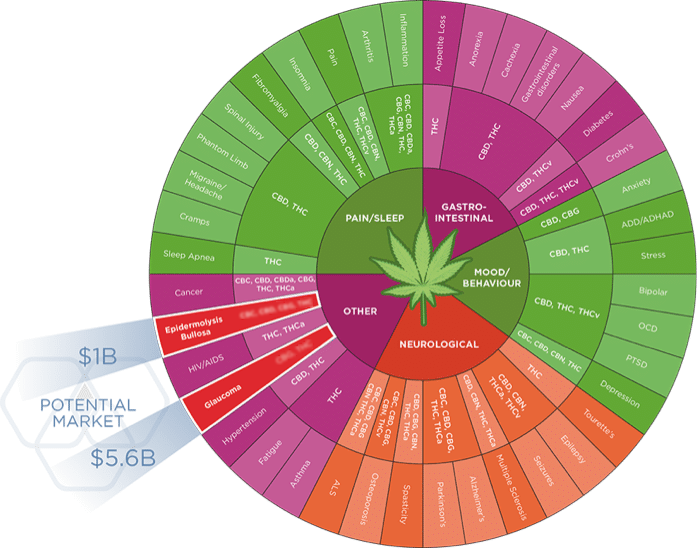
Cannabinoid Science Overview
The majority of pharmaceutical and academic research & development activities investigating the physiological and disease-fighting properties of cannabis revolves around the understanding of one class of biologically active ingredients, the cannabinoids. In the 1960s, several compounds were isolated from the cannabis plant. While there are over 100 different cannabinoids identified in cannabis, the two most well-known and studied compounds in the cannabis plant also happen to be the two that occur in the largest quantity: Δ9-tetrahydrocannabinol (“THC”) and cannabidiol (“CBD”). Many of the remaining compounds demonstrate unique properties and mechanisms apart from those of psychoactive THC and non-psychoactive cannabidiol.
While cannabinoids were first discovered in the 1940’s, the structure of THC was first determined in 1964. Due to molecular similarity and ease of synthetic conversion, it was originally believed that CBD was a natural precursor to THC. However, it is now known that CBD and THC are produced independently in the cannabis plant.
Individual cannabinoids affect a range of different receptors in the human body, including, but not limited to, the endocannabinoid receptors. As such, they are responsible for a wide variety of pharmacological effects. However, due to the limited research into these varying effects, a full understanding of the role of each cannabinoid compound remains elusive.
Until recently, the US Food and Drug Administration (FDA) had only approved one cannabinoid-based medication, Dronabinol, which was approved by the FDA in 1985. Dronabinol (Marinol® and Syndros®) is a synthetic form of THC, and is indicated as an appetite stimulant for people with AIDS and antiemetic for people receiving chemotherapy. Due to the psychoactive attributes associated with THC, Dronabinol is only available as a prescription drug in the United States, as well as other countries, and has been deemed a Schedule III drug by the Drug Enforcement Administration (DEA), as defined by the United States Controlled Substances Act. Dronabinol is considered to be non-narcotic and to have a low risk of physical or mental dependence.
Importantly, however, in June 2018, the FDA approved an oral formulation of cannabidiol (or CBD), Epidiolex®, developed by GW Pharmaceuticals PLC, for the treatment of seizures associated with two rare and severe forms of epilepsy in children. Clinical data showed a significant reduction in convulsive seizure frequency. The regulators also reviewed the abuse-related data from preclinical and clinical studies and concluded that “CBD has negligible abuse potential”.
CBD is being studied in clinical trials for treatment of anxiety, post-traumatic stress disorder, pain, schizophrenia, Parkinson’s disorder and Huntington’s disorder.
General Categories of Cannabinoids
Cannabinoids fall into three general types: (1) phytocannabinoids, such as those that can be isolated from the cannabis plant; (2) endogenous cannabinoids (“endocannabinoids”), which are produced naturally in the bodies of humans and animals; and (3) synthesized cannabinoids, which are produced in the laboratory and may have structural deviations from the naturally occurring drugs.
While THC content varies substantially among cannabis strains, it generally represents between 15% and 35% of the cannabinoid content of the plant, and CBD is typically between 1% and 12%.
After THC and CBD, the next group of 8 cannabinoids are prevalent, although far below that of THC in terms of plant content; the remaining ~100+ are found only in trace amounts – none of which can be extracted from the plant economically in any meaningful quantity, and certainly not at commercial scale.
The Endocannabinoid System
Almost every aspect of the body’s functioning involves the endocannabinoid system, such as regulating temperature, appetite, blood sugar, sleep, memory, emotional processing, pain, inflammatory and immune responses. The endocannabinoid system consists of receptors and endocannabinoids found throughout the human body including in the brain, tissues, nerves, glands, immune cells and organs, playing a critical role in maintaining homeostasis. With the important role of the endocannabinoid system on the body’s key functions, researchers have noted that “modulating endocannabinoid system activity may have therapeutic potential in almost all diseases.”
Endogenous cannabinoids, or “endocannabinoids” are naturally produced by the human body and interact with the related endocannabinoid receptor system. Exogenous, or external, cannabinoids mimic the effects and interactions of the body’s endocannabinoids. Cannabinoids act as messengers that bind to cannabinoid receptors, as well as other receptors, signaling the endocannabinoid system into action. Cannabinoid receptors are found throughout the body and are involved in brain function, immune function, pain perception and inflammation.
Before the 1980s, it was often speculated that cannabinoids produced their effects through nonspecific interaction with cell membranes, instead of interacting with specific receptors. The discovery of the first cannabinoid receptors occurred in the 1980s and helped to clarify their role. These receptors are common in mammals, birds, fish and reptiles. While there are numerous cannabinoid receptors in the human body, the two most well-known are the cannabinoid receptor 1 (CB1), which is more significant to the central nervous system, and cannabinoid receptor 2 (CB2), which is more common with the immune system.
CB1 receptors are found primarily in the brain, specifically in the basal ganglia and in the limbic system, including the hippocampus.
They are also found in the cerebellum and in both male and female reproductive systems. CB1 receptors appear to be responsible for the euphoric and anticonvulsive effects of cannabis. On the other hand, CB2 receptors are almost exclusively found in the immune system, with the greatest concentration in the spleen. CB2 receptors appear to be responsible for the anti-inflammatory and possibly other therapeutic effects of cannabis. In addition, minor variations in each receptor have been identified. There is some indication that cannabinoids interact with other receptors in the body, including TRPV1.
The affinity of an individual cannabinoid to each receptor determines the effect of that cannabinoid. Cannabinoids that bind more selectively to certain receptors are more desirable for medical usage.
Phytocannabinoids
Phytocannabinoids occur naturally in the cannabis plant and are concentrated in a viscous resin that is produced in glandular structures known as trichomes. In addition to cannabinoids, the resin is rich in terpenes, which are largely responsible for the scent of the cannabis plant.
There are 100+ known phytocannabinoids. Of these, THC and CBD are the most prevalent and have received the most attention.
THC is the primary psychoactive component of the cannabis plant. Medically, it appears to mitigate pain.
CBD, on the other hand, is not psychoactive and appears to reduce the euphoric effect of THC by blocking the CB1 receptor site. Medically, CBD appears to relieve convulsion, inflammation, anxiety, and nausea.
Cannabinoids can be administered many ways, including topically (creams, ointments, transdermal patches, etc.); by oral ingestion, sublingual absorption or intravenous injection; as well as by smoking and vaporizing. The time to effect and duration of effect will vary depending on the mode of administration. Once in the body, cannabinoids are metabolized mainly in the liver.











